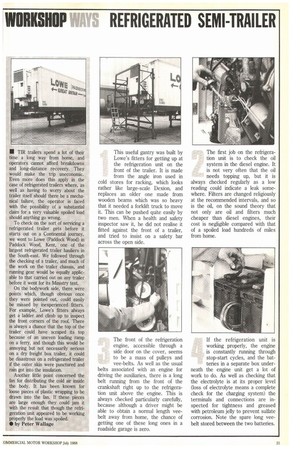REFRIGERATED SEMI-TRAILER
Page 127

If you've noticed an error in this article please click here to report it so we can fix it.
This useful gantry was built by Lowe's fitters for getting up at the refrigeration unit on the front of the trailer. It is made from the angle iron used in cold stores for racking, which looks rather like large-scale Dexion, and replaces an older one made from wooden beams which was so heavy that it needed a forklift truck to move it. This can be pushed quite easily by two men. When a health and safety inspector saw it, he did not realise it fitted against the front of a trailer, and tried to insist on a safety bar across the open side.
The front of the refrigeration engine, accessible through a side door on the cover, seems to be a mass of pulleys and vee-belts. As well as the usual belts associated with an engine for driving the auxiliaries, there is a long belt running from the front of the crankshaft right up to the refrigeration unit above the engine. This is always checked particularly carefully, because although a driver might be able to obtain a normal length veebelt away from home, the chance of getting one of these long ones in a roadside garage is zero. The first job on the refrigeration unit is to check the oil system in the diesel engine. It is not very often that the oil needs topping up, but it is always checked regularly as a low reading could indicate a leak somewhere. Filters are changed religiously at the recommended intervals, and so is the oil, on the sound theory that not only are oil and filters much cheaper than diesel engines, their cost is negligible compared with that of a spoiled load hundreds of miles from home.
If the refrigeration unit is working properly, the engine is constantly running through stop-start cycles, and the batteries in a separate box under neath the engine unit get a lot of work to do. As well as checking that the electrolyte is at its proper level (loss of electrolyte means a complete check for the charging system) the terminals and connections are inspected for tightness and greased with petroleum jelly to prevent sulfate corrosion. Note the spare long veebelt stored between the two batteries.
















































































































































